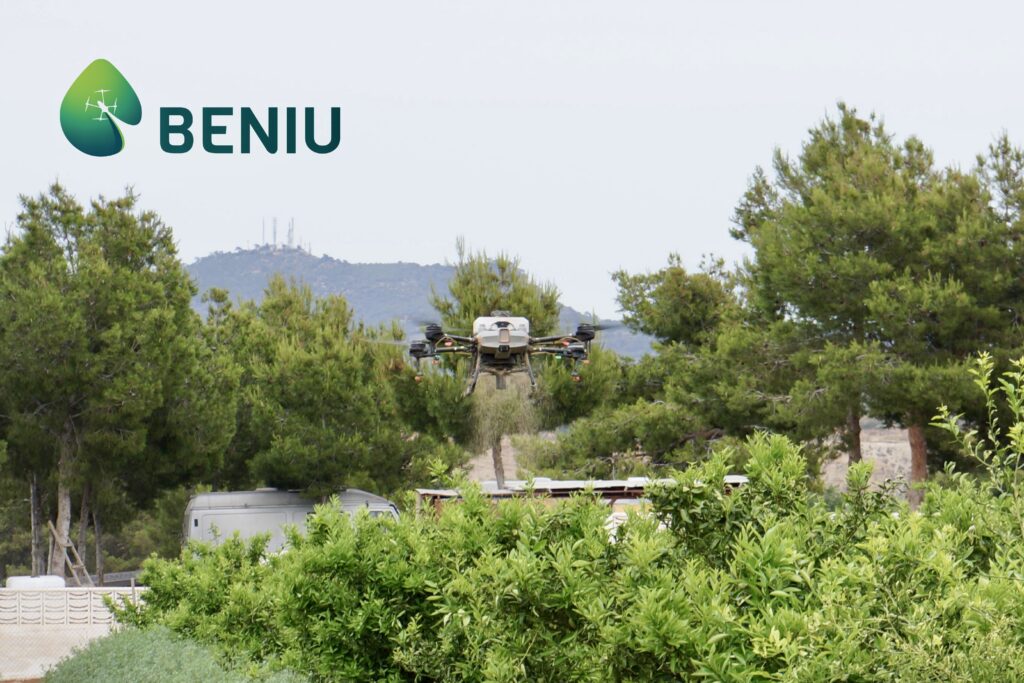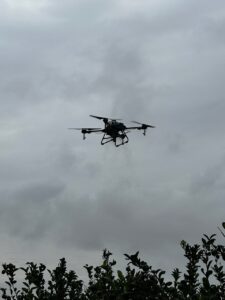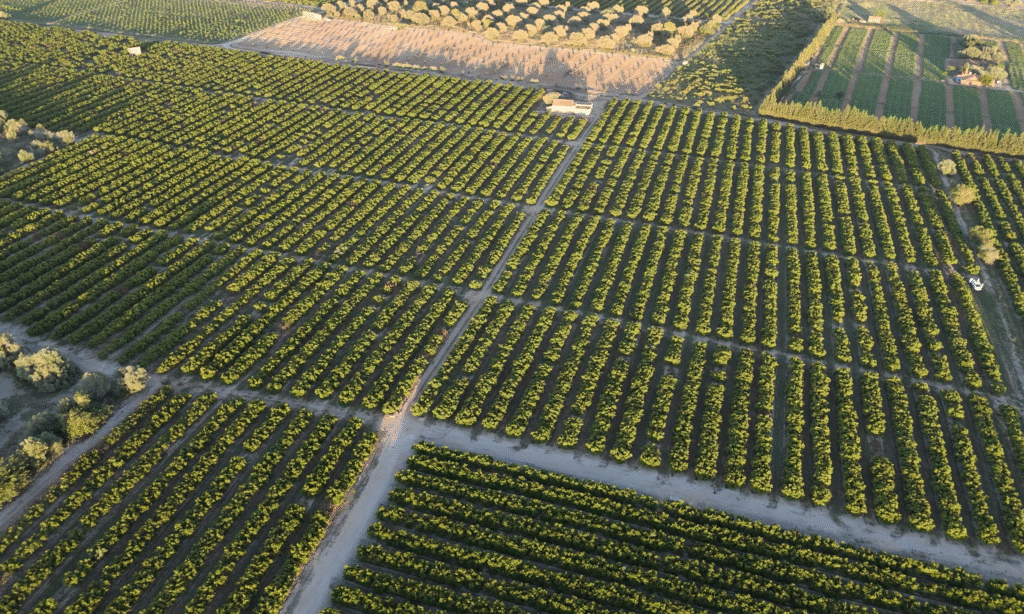Biological control with drones
For decades, agricultural pest control has relied heavily on chemical products which, although providing quick results, also produced side effects: loss of biodiversity, soil and water pollution, pest resistance, and rising production costs. Today, agriculture faces an unavoidable challenge: to produce more with less environmental impact.
In this context, a new way of understanding crop protection emerges: biological control or biocontrol with drones—an innovative technique that combines the release of beneficial insects or biological agents with high-precision aerial systems. Thanks to the use of agricultural drones, these organisms are evenly distributed over crops, allowing farmers to protect plants from pests efficiently and sustainably. This method drastically reduces the need for chemical pesticides, minimizes environmental impact, and optimizes agricultural resources while improving soil health and promoting the natural biodiversity of the agricultural environment.
What is biological control
Biological control, also known as biocontrol, is an agricultural technique based on a simple principle: using nature to protect nature. It involves the use of living organisms that act as natural enemies of pests, helping to maintain the ecological balance of the crop without the need for chemical pesticides.
These biological agents—such as insects, mites, or microorganisms—are released into the field to regulate harmful pest populations naturally and selectively. Instead of indiscriminately eliminating beneficial fauna, biological control respects biodiversity and improves the resilience of the agricultural ecosystem.
Unlike chemical treatments, which can leave residues and alter soil microbiota, biocontrol promotes a healthy and sustainable environment, capable of self-regulating with minimal human intervention. Moreover, this strategy fits perfectly into organic farming and precision agriculture programs where sustainability is key.
Common examples of organisms used in biocontrol
- Phytoseiids such as Amblyseius swirskii or Amblyseius andersoni: predatory mites essential for controlling spider mites, thrips, and whiteflies, widely used in fruit trees, horticultural crops, and extensive farming.
- Trichogramma spp.: tiny parasitoid wasps used to control lepidopterans, such as corn borers or codling moths in fruit crops.
- Chrysoperla carnea (green lacewing): a versatile predator that feeds on whiteflies, aphids, and thrips, widely used for its adaptability and reproductive capacity.
Together, these species form the heart of modern biological control—a method that not only combats pests but also strengthens soil health, improves pollination, and reduces the ecological footprint of agricultural activity.
How it was done until now
Before aerial technology was introduced, biological control was carried out entirely by hand. Technicians or farmers released beneficial organisms directly onto plants or at strategic points in the field, walking through plots or using agricultural vehicles. This method proved useful for small farms, greenhouses, or highly controlled areas, but had clear limitations when it came to medium or large-scale operations.
Limitations of the traditional biological control model
Manual release required a great deal of time and physical effort. Each insect, mite, or biological capsule had to be placed or distributed manually, increasing labor costs and making it difficult to maintain a consistent application frequency. In addition, distribution depended entirely on the operator’s skill and terrain conditions, leading to irregular coverage and variable effectiveness between plots.
Another major issue was the lack of traceability. It was almost impossible to document precisely where, when, and how many organisms had been released in each area, complicating later evaluations or treatment comparisons.
In short, while traditional biological control proved effective on a small scale, it could not meet the demands of modern agriculture, where fields span hectares and efficiency, precision, and digital monitoring are essential.
This reality opened the door to innovation: the use of agricultural drones as a tool for aerial biocontrol—capable of covering large areas in minutes, with full traceability and perfectly uniform distribution of beneficial organisms.
The transformation with drones
Agricultural drones have changed the landscape. Equipped with specific release systems, they distribute organisms evenly, precisely, and with documentation—even in complex or large-scale areas.
Several hectares can be covered in minutes, and each flight is recorded via GPS, providing real traceability and analytical capability.
The advent of agricultural drones has marked a turning point in the field of biological control. This technology has made it possible to overcome the limitations of manual labor and take biocontrol to a new level of precision, speed, and sustainability.
Equipped with specialized release systems, drones distribute beneficial organisms evenly and in a controlled manner, ensuring crop protection with maximum efficiency. Each flight is planned with specialized software that defines routes, altitude, and exact dosage, and is recorded by GPS, ensuring consistent results even over large or difficult terrain.
Efficiency and traceability in every flight
Biological control with drones stands out for its speed and precision. In just minutes, they can cover several hectares, optimizing time and reducing operating costs. Unlike manual methods, each application is recorded via GPS, providing full process traceability. These data make it possible to analyze the effectiveness of each release, compare results between plots, and adjust future applications based on real, measurable information.
Sustainability and precision
In addition to its efficiency, aerial biocontrol contributes to more sustainable farming. Since no heavy machinery is required, soil compaction is avoided and fuel consumption is reduced. The use of living organisms instead of chemicals protects biodiversity, improves soil health, and integrates perfectly into the organic and regenerative farming programs promoted by Beniu.
Advantages of biological control with drones
The application of biological control with drones offers a unique combination of efficiency, sustainability, and traceability that sets it apart from traditional methods. This aerial technology allows crops to be protected naturally and precisely, ensuring measurable results and minimal environmental impact.
Efficiency, uniformity, and traceability
One of the main advantages of aerial biocontrol is its ability to cover large areas in a very short time. Beniu’s agricultural drones are equipped with automated systems that ensure uniform distribution of beneficial organisms, achieving homogeneous coverage even on uneven or difficult terrain. This precision in release translates into greater treatment effectiveness and a significant reduction in required resources.
Each flight is recorded using GPS, providing complete traceability: documenting treated zones, applied doses, and exact dates of intervention. This information facilitates post-analysis, comparison between plots, and the continuous improvement of biological control strategies.
Sustainability and environmental responsibility
In addition to its effectiveness, biological control with drones brings invaluable environmental benefits. By replacing chemical pesticides with living organisms that act naturally, soil and water pollution are reduced, and the accumulation of chemical residues in food is avoided. The process requires no heavy machinery, minimizing soil compaction and fuel use, and contributing to cleaner, more efficient agriculture.
This aerial biocontrol model is fully compatible with organic farming and with the biodiversity conservation programs promoted by Beniu. The result is effective crop protection that is safe for the environment and aligned with the principles of regenerative and sustainable agriculture.
Beniu and the future of sustainable agriculture
At Beniu, we combine aerial technology, agronomic knowledge, and environmental commitment to promote a new way of producing—more efficient, regenerative, and respectful of the environment. Through biological control with drones, we release beneficial organisms professionally, precisely, and traceably, tailoring each flight to the crop type, its phenological stage, and the real needs of each agricultural operation.
This methodology optimizes biocontrol programs in citrus, fruit trees, vineyards, and extensive crops, ensuring uniform distribution, digital monitoring of each intervention, and a significant reduction in pesticide use. The result is healthier plantations, richer soils, and more balanced agricultural ecosystems.
Technology and biology at the service of farmers
At Beniu, we understand that technology does not replace the farmer—it empowers them. Drones become a tool that enhances their expertise, improving treatment efficiency, reducing operational costs, and caring for the environment that makes production possible.
The agriculture of the future is already underway. It combines the wisdom of the land with the precision of engineering and the strength of applied biology. Through aerial biocontrol, Beniu actively contributes to building a production model that is more intelligent, sustainable, and aligned with the environmental and climate challenges of the 21st century.



